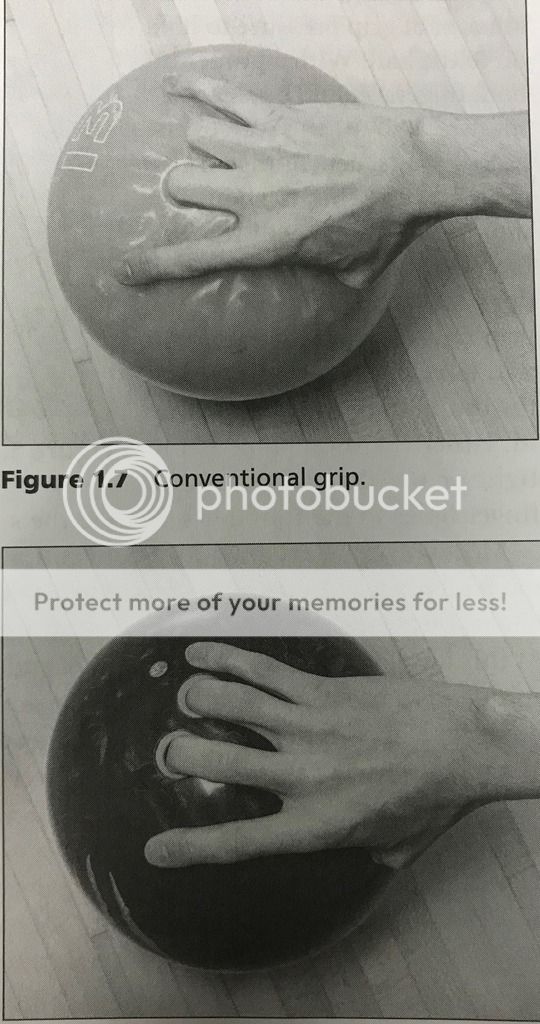Get A Grip
Written By: bowlingball.com | Written On: Thursday, September 6, 2018
Excerpt from Bowling Fundamentals - Second Edition By Michelle Mullen
9/9/2018
The two types of grips are the conventional grip and fingertip grip. Most bowlers begin with the conventional grip and eventually graduate to a fingertip grip.
Each finger has two joints. For ease of reference, think of the join nearest the fingertip as the first joint and the joint in the middle of the finger as the second joint. In a conventional grip (see top photo), the fingers go into the holes up to the second joint in the middle of the finger. On a ball that is drilled for conventional grip, the finger holes are closer to the thumb and are larger to accommodate the size of the finger up to the second joint. Once the fingers are in, the thumb should go into the hole all the way to the base of the thumb. Most bowlers start out with a conventional grip because it makes them feel more secure when swinging the ball.
In the fingertip grip (see bottom photo), the fingers go into the holes up to the first finger joint. On a ball that is drilled for fingertip grip, the finger holes are drilled farther from the thumb, compared to a ball drilled for a conventional grip, and the holes are smaller to accommodate the smaller size of just the fingertips, from the first joint to the tip. Once the fingers are in, the thumb should go into the hole all the way to the base of the thumb.

A fingertip grip eventually is the preferred grip because it allows you to create more revolutions at release. In the fingertip grip, the thumb comes out much sooner than the fingers, as compared to the conventional grip, in which the thumb and fingers come out closer together. Because the ball has more time over the fingers, it has more roll. NOTE: It is a myth that it is more difficult to hold onto a ball using fingertip grip because only the very tips of the fingers are in it. The ball is actually still fit securely at a joint (which is why a semi-fingertip grip is not suggested- you should be fit to the joints). If the ball is fit properly for your hand, you can easily hold on to it using the fingertip grip without increasing grip pressure.
With both grips, the thumb exits before the fingers during release. The length of time from thumb release to finger release varies between the two grips because of the amount of hand spanning over the ball.
To maintain a loose, natural arm swing, use a minimal amount of grip pressure to hold on to the ball. With a proper fit, both fingers should be able to go into the ball all the way to the proper joints, depending on grip type, and the thumb should go into the thumbhole all the way. If the thumb does not go all the way in, the grip will feel insecure and you will tend to squeeze the ball. If the thumb cannot go all the in, either the thumbhole is too tight or the distance from the finger holes to the thumbhole, called the span, is too wide.
Most bowlers start out with a conventional grip because it initially feels like a more secure grip. Once you develop an established level of consistency- typically when you average around 150 or so- a fingertip grip becomes the preferred grip.
At this level, you are hitting the pocket and picking up spares more consistently and need to begin developing more pin action when the ball hits the pocket. A fingertip grip will help you strike more as well as create better pin count on the first shot to leave easier spares (with fewer pins) to pick up on the second shot.
In a good release, the thumb exits the ball before the fingers. Because the fingers and thumb release closer together using a conventional grip, whereas the thumb clears much sooner than the fingers using a fingertip grip, a fingertip grip creates more revolutions on the ball. Releasing from a fingertip grip creates a quicker transfer of the ball weight from the thumb to the fingers to impart more roll off the fingers at release. Bowlers with higher averages and professional bowlers use a fingertip grip for its superior effect on the roll of the ball. It creates better pin action when the ball strikes the pocket.
Mullen, Michelle. Bowling Fundamentals- Second Edition. Champaign, IL: Human Kinetics, 2014.

